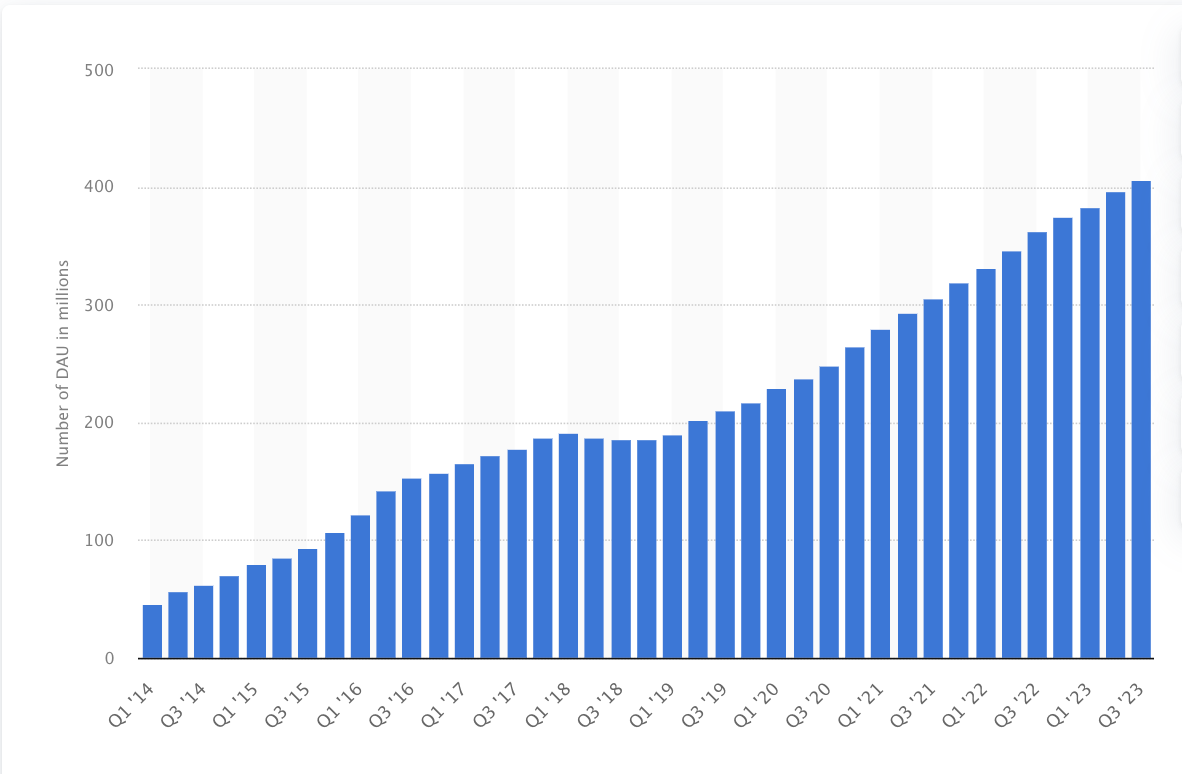SEO
17 Types Of Content Marketing You Can Use

For marketers, content is still king. It provides value to your targets, helps establish you as an expert in your field, drives traffic, and tells search engines why your website should be ranked highly.
But what’s the best type of content? You would likely get 12 different responses if you asked a dozen marketers.
Some will swear by blogs, while others will claim infographics are the best way to generate exposure. Ebooks can be a great way to establish your authority, while memes encourage organic shares.
Every type of content has different strengths and weaknesses. By understanding each offer’s unique benefits, you can develop a cohesive content marketing strategy unique to your needs.
In this piece, we’ll take a look at 17 types of marketing content, explain how you can use them to achieve your goals, and give you the knowledge you need to make a bigger splash with your marketing.
Why Content Marketing Is Important
The world has gone digital. As of July 2022, there were 5.03 billion people worldwide using the internet. That means 63.1% of the global population could potentially land on your website.
Thanks to smartphones, the internet has become the go-to source for entertainment, shopping, or settling arguments about Florida’s state bird (the northern mockingbird), no matter where you are.
With this in mind, it’s no surprise that a study by the Pew Research Center found 31% of American adults reported being online “almost constantly.”
The heart of any successful digital marketing campaign, content marketing offers several benefits, including:
- Building trust with your audience.
- Improving SEO efforts.
- Showcasing your expertise.
- Helping maintain your brand’s reputation.
- Encouraging social shares.
- Improving conversion rates.
And on top of this, it’s one of the most cost-effective ways to attract new leads, as you can often repurpose your content to get added exposure without a lot more work.
Of course, not all types of content will reap the same level of rewards. Your mix will depend on the specifics of your business and your goals, but some types are essential.
17 Essential Types Of Content
1. Blogs
Since 1994, when Justin Hall created the very first weblog, or blog, as it would come to be known, blogging has been a cornerstone of successful content marketing.
A great way to regularly add new content to your website, blogs are a versatile, low-cost, and often evergreen way to boost organic traffic.
Their long-form format lets you focus on your target keywords and the important topics to your audience.
Blogs can also play an important role in your SEO strategy.
Their length (the average blog post is 1,500 to 2,500 words) provides Google’s search bots with a lot of information about their content, which in turn helps it determine how it helps answer search queries.
To ensure your blog posts are generating as much traffic as possible and getting the results you need, make sure they are:
- Written for humans – not search engines.
- Use your targeted keywords.
- Optimized for loading speed.
- Linked to sites with high authority.
- Use headers for effective skimming.
And don’t forget your long-tail keywords. Remember, the more detailed a blog post is, the more likely it will attract the traffic you want.
Plus, it’s a great way to show off your brand’s personality.
2. Case Studies
Your target customers have a specific problem. Your goal as a marketer is to show them why your business is the best answer to said problem.
To do this, you have to demonstrate not just that you’re an expert in the field but also that your solution actually works. And one of the best ways to do this is through case studies.
Case studies give your audience a real-life scenario in which someone like them used your offering to solve their problem. They see the buying journey from start to finish, helping them visualize how your product or service works.
They allow you to portray yourself as an expert, which helps reduce perceived risk, particularly for high-cost products and services.
And like blogs, they offer a longer format in which you can effectively add keywords without feeling like they were shoehorned in.
To maximize their impact, you should make sure your case studies:
- Focus on an issue your target audience can relate to.
- Feature a cohesive narrative from start to finish.
- Include real statistics wherever possible.
- Accurately portray how your business solved the issue.
3. Checklists
Santa Claus is not the only one making a list and checking it twice. Many people love a step-by-step guide to performing a task or solving a problem.
By dividing tasks into smaller, more manageable ones, checklists can make even the most complex jobs less daunting. And from a marketing perspective, they’re a great way to generate leads.
Audiences use them as a simple, easy, and free way to make sure all the right steps are being followed. They create ownership, establish expectations, and set deadlines, all of which contribute to productivity.
In addition to creating a useful tool for customers, checklists also let your targets know you understand what they’re facing. Good checklists will include:
- A title establishing the purpose of the list and why it’s useful.
- Step-by-step tasks that outline the overall process – including subtasks.
- Timeframes for each step – this could be a hard date or a range.
- Status indicating whether a step is completed, in progress, or not started.
4. Customer Reviews And Testimonials
You know your business is great, but let’s face it: saying it yourself doesn’t count for much. What does matter, however, is what your customers are saying.
Word of mouth for the digital age, customer reviews, and testimonials give you a level of credibility no amount of paid marketing can ever achieve.
Studies have shown 93% of consumers say online reviews impact their shopping choices, which makes them extremely valuable.
Reviews and their less-celebrated-but-no-less-important-counterpart testimonials help reduce the feeling of risk and provide a useful way to overcome potential objections. Plus, because they’re customer-generated, they cost you nothing.
There are several ways to encourage them, including:
- Directly asking for reviews and testimonials.
- Incentivizing customers to create them.
- Creating automated replies that make creating reviews easy.
Google factors in positive reviews when determining Search Quality Raters Guidelines.
These do not have a direct impact on search rankings but do help ensure your pages meet the minimum quality threshold the search engine demands.
You should prominently feature testimonials and reviews wherever they logically fit, including on webpages and in emails.
5. Ebooks
One of the best ways to present yourself as an authority is to demonstrate thought leadership. And one of the best ways to do that is by creating an ebook.
These long-form texts are not advertisements, at least not in the traditional sense, but instead, they offer value to potential customers.
By deep diving into a subject particular to your field, you demonstrate your expertise while simultaneously providing value to your targets.
If your ebook covers a particularly under-covered topic or presents information in a new light, it can lead to significant interest in your company. And even better, because these long-form texts are generally hidden behind an email or contact form, they offer a great way to generate new leads.
6. Email Marketing
The bread-and-butter of marketing in the 21st century, email marketing is a fast and flexible way to reach a highly targeted audience.
Whether you’re trying to stay top of mind for existing customers, reach new ones, or build brand awareness, email marketing gives you a measurable way to engage with targets.
You should be using email to contact people regularly at each stage of your sales funnel.
Limited-time offers can help persuade that hesitant lead to finally give you a chance. Birthday messages to existing customers help keep your brand at the forefront, and abandoned cart emails can entice people back to complete purchases.
No matter what your business goals are, there’s an email strategy to help you achieve them.
Make sure you keep your strategy centered on those goals, segment your audience to speak to specific audiences, and measure your results. Then, take what you have learned from this campaign and apply it to the next one.
7. Guides And How-Tos
In-depth guides and how-tos are necessary for any company offering a complex product or service.
Another way to demonstrate how knowledgeable you are, they are a great way to expand your online presence.
For example, if you are a software company, providing how-to content in the form of printable guides or online training courses will help your clients get the most from your product.
They can also help eliminate frustration and minimize learning curves – both things customers love.
8. Infographics
Everyone knows a picture is worth a thousand words. Infographics are this adage applied to marketing.
By allowing you to present a significant amount of information in a quick and easy-to-understand format, they provide an easy way for viewers to understand information.
Great for catching the eyes of people who only scan the text on your webpage (which is almost everyone), infographics give marketers control over which information is highlighted.
Create infographics that call out statistics, events, or timelines that help pitch your business. Quick and low-cost, they often act as standalone content that can be shared on social media.
To ensure you’re getting all the credit (and backlinks) you deserve from your content, include a snippet of HTML code that allows other webmasters to embed them on their sites.
9. Interactive Content
In the old days (i.e., before the internet), marketing usually talked “at” an audience. But now, the power of technology has given marketers the ability to speak “with” people.
Interactive content is a great way to harness this functionality to gather information, boost engagement, or find new customers. Plus, they’re a great way to provide value and/or showcase your creativity.
Create quizzes to help people decide on which product is perfect for their needs, build games to distract them while increasing your brand’s exposure, or create an app that adds value to their lives.
While this type of content may require a bit more technological knowledge (or outsourcing) than some of the items on this list, it can also be one of the highest-performing.
10. Interviews/Q&As
Want to massively expand your audience with just one piece of content? All you need to do is secure an interview on Joe Rogan’s podcast. Simple, right? Well, maybe not, but don’t let that discourage you from putting the power of interviews and question-and-answer segments to work for you.
A great way to build relationships (and links) with other websites, these are a great way for your internal thought leaders to showcase their knowledge to external audiences.
By going “on the record,” you’re showing the world that you stand behind your offering. This implies quality customer support, helps with reputation management, and can improve overall engagement.
11. Listicles
Unfamiliar with the word “listicle?” You’re not alone. But they refer to something you’ve definitely seen before. In fact, you’re reading one right now – it’s an article structured as a list, hence the name.
While the most popular of these are often Buzzfeed-esque pieces like “15 Hedgehogs With Things That Look Like Hedgehogs,” they don’t have to be mindless entertainment but instead can be used as powerful pieces of marketing content.
People love listicles because they are easy to skim, you know what to expect, and they break information down into digestible chunks.
Marketers love them because they’re easy to plan and write.
Create your own marketing listicles following these steps:
- Choose a topic and angle.
- Select a keyword.
- Write the list points.
- Wrap up with a solid conclusion.
12. Podcasts
No longer solely the domain of true crime junkies, podcasts are a great way to build your brand with effective content marketing that people can consume on their commute, on a walk, or at any other time they find convenient.
Podcasts allow you to share your stories and experiences directly with your audience, building relationships by speaking to your targets on a personal level.
To maximize the impact of your podcasts, ensure you’re providing useful information in an entertaining format. You can also use guest hosts or interviewees as a way to expand your audience.
13. Social Media Posts
Everyone from your grandmother to the teenager next door is using social media these days.
While it’s true they might not be on the same platform, they’re all using it for the same purpose – to stay in touch. And there are literally billions of users worldwide.
Providing a way to initiate and maintain conversations with targets, social media has become an important part of every marketing mix.
Of course, how you use it will vary dramatically from one company to the next.
For example, a candy manufacturer may have good luck with recreating viral videos on TikTok, but that approach will probably fall flat for a software developer.
To ensure your social media efforts are reaping maximum rewards, you need to identify which platform or platforms your audience is using, then create content that will speak to them.
Seek to build relationships with both your audience and any influencers who can help expand the impact of your content.
And don’t forget, social media is also a great place to repurpose content you’ve already created.
Have a great infographic? That would be perfect for your Facebook. That tutorial video about your product’s hidden features should be on your YouTube page. Linking to your ebook on Twitter can help you land new leads.
Find where your content fits, then put it on your social channels.
14. User-Generated Content
Much like testimonials, content created by your users gives you an authenticity no amount of self-promotion can match. Even better, because it’s generated by a third party, it doesn’t take much investment on your part.
User-generated content, or UGC, could be anything from someone tagging your brand in a selfie to a recording of them using your product. It provides social proof while simultaneously providing word of mouth and encouraging engagement.
Encourage your fans and customers to make content by:
- Regularly posting UGC on your social media channels.
- Inviting user-submitted content, with or without rewards.
- Creating and using your own branded hashtag.
15. Videos
If you’re looking for a way to engage your audience, there’s nothing quite like video.
Platforms like YouTube, TikTok, and Meta’s Reels have made videos a ubiquitous part of digital marketing. And with good reason – video content works.
While this type of content generally requires more time and resources to produce than text or static content, video content has been shown to increase dwell time, improve customer understanding of your product or service, and lead to higher lead volume.
Part of the strength of video content lies in its versatility.
From short demo videos and social media clips to interviews and long-term videos that tell your story, video can help you connect with your audience in a way most other forms of content can’t.
16. Webinars
When you think of content marketing, webinars are probably not the first thing that springs to mind. However, they can be a very valuable part of your strategy.
Whether you’re using on-demand webinars to provide round-the-clock value or live sessions to create personal connections, these online education sessions are a great way to educate existing and potential customers, attract new leads, and establish your authority in your field.
To create successful webinars, first, identify an area of need. Maybe there’s a new law that impacts your industry, and there are many questions surrounding its implementation.
Maybe there’s a certain aspect of your offering that customers don’t seem to understand clearly. Or perhaps you just want to offer expert insights on a relevant topic.
Whatever it is, your webinars should provide unique content that adds value. Require an email list for registration, and they provide a great way to build new contact lists.
17. Whitepapers
Not to be confused with ebooks, whitepapers are lengthy papers filled with data, statistics, and information – sort of like business research papers.
The information they include can be the results of your own studies or a compilation of information compiled from other sources. Either way, they should offer key takeaways and provide credible insights.
Keep your design clean and visually appealing for easy scanning, and allow others to link to it to help generate backlinks.
Takeaway: Why Use Different Types Of Content
Though they may have common features, every prospect, lead, and customer you’re targeting differs.
Some people are visual learners and like videos and infographics. Others prefer to be taught new information and retain information from webinars best. And yet, others prefer downloadable texts they can peruse on their own time.
If you’re only creating one type of content, you’re not reaching as many targets as possible with a more varied approach.
It’s often tempting for busy marketers to take the easiest approach, but this isn’t the best recipe for long-term success.
Instead, determine what your goals are and how you will define success. Then, use this to create a multi-channel content plan that will help you reach it.
Regardless of which content mix you opt for, there are certain things every element, regardless of format, must do:
- It should provide value.
- It should promote your brand and product/service.
- It should be targeted to your specific desired audience.
- It should actively move customers along the purchasing journey.
- It should be shareable.
Don’t be afraid to experiment and take risks. Not every type of content works for every brand, but if you put in the work, you’re sure to see rewards.
More Resources:
Featured Image: Gorodenkoff/Shutterstock
window.addEventListener( ‘load’, function() {
setTimeout(function(){ striggerEvent( ‘load2’ ); }, 2000);
});
window.addEventListener( ‘load2’, function() {
if( sopp != ‘yes’ && addtl_consent != ‘1~’ && !ss_u ){
!function(f,b,e,v,n,t,s)
{if(f.fbq)return;n=f.fbq=function(){n.callMethod?
n.callMethod.apply(n,arguments):n.queue.push(arguments)};
if(!f._fbq)f._fbq=n;n.push=n;n.loaded=!0;n.version=’2.0′;
n.queue=[];t=b.createElement(e);t.async=!0;
t.src=v;s=b.getElementsByTagName(e)[0];
s.parentNode.insertBefore(t,s)}(window,document,’script’,
‘https://connect.facebook.net/en_US/fbevents.js’);
if( typeof sopp !== “undefined” && sopp === ‘yes’ ){
fbq(‘dataProcessingOptions’, [‘LDU’], 1, 1000);
}else{
fbq(‘dataProcessingOptions’, []);
}
fbq(‘init’, ‘1321385257908563’);
fbq(‘track’, ‘PageView’);
fbq(‘trackSingle’, ‘1321385257908563’, ‘ViewContent’, {
content_name: ‘types-of-content-marketing’,
content_category: ‘content seo’
});
}
});
SEO
OpenAI Expected to Integrate Real-Time Data In ChatGPT

Sam Altman, CEO of OpenAI, dispelled rumors that a new search engine would be announced on Monday, May 13. Recent deals have raised the expectation that OpenAI will announce the integration of real-time content from English, Spanish, and French publications into ChatGPT, complete with links to the original sources.
OpenAI Search Is Not Happening
Many competing search engines have tried and failed to challenge Google as the leading search engine. A new wave of hybrid generative AI search engines is currently trying to knock Google from the top spot with arguably very little success.
Sam Altman is on record saying that creating a search engine to compete against Google is not a viable approach. He suggested that technological disruption was the way to replace Google by changing the search paradigm altogether. The speculation that Altman is going to announce a me-too search engine on Monday never made sense given his recent history of dismissing the concept as a non-starter.
So perhaps it’s not a surprise that he recently ended the speculation by explicitly saying that he will not be announcing a search engine on Monday.
He tweeted:
“not gpt-5, not a search engine, but we’ve been hard at work on some new stuff we think people will love! feels like magic to me.”
“New Stuff” May Be Iterative Improvement
It’s quite likely that what’s going to be announced is iterative which means it improves ChatGPT but not replaces it. This fits into how Altman recently expressed his approach with ChatGPT.
He remarked:
“And it does kind of suck to ship a product that you’re embarrassed about, but it’s much better than the alternative. And in this case in particular, where I think we really owe it to society to deploy iteratively.
There could totally be things in the future that would change where we think iterative deployment isn’t such a good strategy, but it does feel like the current best approach that we have and I think we’ve gained a lot from from doing this and… hopefully the larger world has gained something too.”
Improving ChatGPT iteratively is Sam Altman’s preference and recent clues point to what those changes may be.
Recent Deals Contain Clues
OpenAI has been making deals with news media and User Generated Content publishers since December 2023. Mainstream media has reported these deals as being about licensing content for training large language models. But they overlooked a a key detail that we reported on last month which is that these deals give OpenAI access to real-time information that they stated will be used to give attribution to that real-time data in the form of links.
That means that ChatGPT users will gain the ability to access real-time news and to use that information creatively within ChatGPT.
Dotdash Meredith Deal
Dotdash Meredith (DDM) is the publisher of big brand publications such as Better Homes & Gardens, FOOD & WINE, InStyle, Investopedia, and People magazine. The deal that was announced goes way beyond using the content as training data. The deal is explicitly about surfacing the Dotdash Meredith content itself in ChatGPT.
The announcement stated:
“As part of the agreement, OpenAI will display content and links attributed to DDM in relevant ChatGPT responses. …This deal is a testament to the great work OpenAI is doing on both fronts to partner with creators and publishers and ensure a healthy Internet for the future.
Over 200 million Americans each month trust our content to help them make decisions, solve problems, find inspiration, and live fuller lives. This partnership delivers the best, most relevant content right to the heart of ChatGPT.”
A statement from OpenAI gives credibility to the speculation that OpenAI intends to directly show licensed third-party content as part of ChatGPT answers.
OpenAI explained:
“We’re thrilled to partner with Dotdash Meredith to bring its trusted brands to ChatGPT and to explore new approaches in advancing the publishing and marketing industries.”
Something that DDM also gets out of this deal is that OpenAI will enhance DDM’s in-house ad targeting in order show more tightly focused contextual advertising.
Le Monde And Prisa Media Deals
In March 2024 OpenAI announced a deal with two global media companies, Le Monde and Prisa Media. Le Monde is a French news publication and Prisa Media is a Spanish language multimedia company. The interesting aspects of these two deals is that it gives OpenAI access to real-time data in French and Spanish.
Prisa Media is a global Spanish language media company based in Madrid, Spain that is comprised of magazines, newspapers, podcasts, radio stations, and television networks. It’s reach extends from Spain to America. American media companies include publications in the United States, Argentina, Bolivia, Chile, Colombia, Costa Rica, Ecuador, Mexico, and Panama. That is a massive amount of real-time information in addition to a massive audience of millions.
OpenAI explicitly announced that the purpose of this deal was to bring this content directly to ChatGPT users.
The announcement explained:
“We are continually making improvements to ChatGPT and are supporting the essential role of the news industry in delivering real-time, authoritative information to users. …Our partnerships will enable ChatGPT users to engage with Le Monde and Prisa Media’s high-quality content on recent events in ChatGPT, and their content will also contribute to the training of our models.”
That deal is not just about training data. It’s about bringing current events data to ChatGPT users.
The announcement elaborated in more detail:
“…our goal is to enable ChatGPT users around the world to connect with the news in new ways that are interactive and insightful.”
As noted in our April 30th article that revealed that OpenAI will show links in ChatGPT, OpenAI intends to show third party content with links to that content.
OpenAI commented on the purpose of the Le Monde and Prisa Media partnership:
“Over the coming months, ChatGPT users will be able to interact with relevant news content from these publishers through select summaries with attribution and enhanced links to the original articles, giving users the ability to access additional information or related articles from their news sites.”
There are additional deals with other groups like The Financial Times which also stress that this deal will result in a new ChatGPT feature that will allow users to interact with real-time news and current events .
OpenAI’s Monday May 13 Announcement
There are many clues that the announcement on Monday will be that ChatGPT users will gain the ability to interact with content about current events. This fits into the terms of recent deals with news media organizations. There may be other features announced as well but this part is something that there are many clues pointing to.
Watch Altman’s interview at Stanford University
Featured Image by Shutterstock/photosince
SEO
Google’s Strategies For Dealing With Content Decay

In the latest episode of the Search Off The Record podcast, Google Search Relations team members John Mueller and Lizzi Sassman did a deep dive into dealing with “content decay” on websites.
Outdated content is a natural issue all sites face over time, and Google has outlined strategies beyond just deleting old pages.
While removing stale content is sometimes necessary, Google recommends taking an intentional, format-specific approach to tackling content decay.
Archiving vs. Transitional Guides
Google advises against immediately removing content that becomes obsolete, like materials referencing discontinued products or services.
Removing content too soon could confuse readers and lead to a poor experience, Sassman explains:
“So, if I’m trying to find out like what happened, I almost need that first thing to know. Like, “What happened to you?” And, otherwise, it feels almost like an error. Like, “Did I click a wrong link or they redirect to the wrong thing?””
Sassman says you can avoid confusion by providing transitional “explainer” pages during deprecation periods.
A temporary transition guide informs readers of the outdated content while steering them toward updated resources.
Sassman continues:
“That could be like an intermediary step where maybe you don’t do that forever, but you do it during the transition period where, for like six months, you have them go funnel them to the explanation, and then after that, all right, call it a day. Like enough people know about it. Enough time has passed. We can just redirect right to the thing and people aren’t as confused anymore.”
When To Update Vs. When To Write New Content
For reference guides and content that provide authoritative overviews, Google suggests updating information to maintain accuracy and relevance.
However, for archival purposes, major updates may warrant creating a new piece instead of editing the original.
Sassman explains:
“I still want to retain the original piece of content as it was, in case we need to look back or refer to it, and to change it or rehabilitate it into a new thing would almost be worth republishing as a new blog post if we had that much additional things to say about it.”
Remove Potentially Harmful Content
Google recommends removing pages in cases where the outdated information is potentially harmful.
Sassman says she arrived at this conclusion when deciding what to do with a guide involving obsolete structured data:
“I think something that we deleted recently was the “How to Structure Data” documentation page, which I thought we should just get rid of it… it almost felt like that’s going to be more confusing to leave it up for a period of time.
And actually it would be negative if people are still adding markup, thinking they’re going to get something. So what we ended up doing was just delete the page and redirect to the changelog entry so that, if people clicked “How To Structure Data” still, if there was a link somewhere, they could still find out what happened to that feature.”
Internal Auditing Processes
To keep your content current, Google advises implementing a system for auditing aging content and flagging it for review.
Sassman says she sets automated alerts for pages that haven’t been checked in set periods:
“Oh, so we have a little robot to come and remind us, “Hey, you should come investigate this documentation page. It’s been x amount of time. Please come and look at it again to make sure that all of your links are still up to date, that it’s still fresh.””
Context Is Key
Google’s tips for dealing with content decay center around understanding the context of outdated materials.
You want to prevent visitors from stumbling across obsolete pages without clarity.
Additional Google-recommended tactics include:
- Prominent banners or notices clarifying a page’s dated nature
- Listing original publish dates
- Providing inline annotations explaining how older references or screenshots may be obsolete
How This Can Help You
Following Google’s recommendations for tackling content decay can benefit you in several ways:
- Improved user experience: By providing clear explanations, transition guides, and redirects, you can ensure that visitors don’t encounter confusing or broken pages.
- Maintained trust and credibility: Removing potentially harmful or inaccurate content and keeping your information up-to-date demonstrates your commitment to providing reliable and trustworthy resources.
- Better SEO: Regularly auditing and updating your pages can benefit your website’s search rankings and visibility.
- Archival purposes: By creating new content instead of editing older pieces, you can maintain a historical record of your website’s evolution.
- Streamlined content management: Implementing internal auditing processes makes it easier to identify and address outdated or problematic pages.
By proactively tackling content decay, you can keep your website a valuable resource, improve SEO, and maintain an organized content library.
Listen to the full episode of Google’s podcast below:
Featured Image: Stokkete/Shutterstock
SEO
25 Snapchat Statistics & Facts For 2024

Snapchat, known for its ephemeral content, innovative augmented reality (AR) features, and fiercely loyal user base, is a vital player in the social media landscape.
While it sometimes flies under the radar – as other platforms like TikTok, YouTube, and Instagram tend to dominate the cultural conversation – Snapchat is an incredibly powerful marketing tool that holds a unique place in the hearts and minds of its users.
In this article, we’ll explore what you need to know about Snapchat, with insights that shed light on what audiences think of the app and where its strengths lie.
From user growth trends to advertising effectiveness, let’s look at the state of Snapchat right now.
What Is Snapchat?
Snapchat is a social media app that allows users to share photos and videos with friends and followers online.
Unlike other social platforms like Facebook, Instagram, and TikTok – where much of the content is stored permanently – Snapchat prioritizes ephemeral content only.
Once viewed, Snapchat content disappears, which adds a layer of spontaneity and privacy to digital interactions.
Snapchat leverages the power of augmented reality to entertain its audience by creating interactive and immersive experiences through features like AR lenses.
Users can also explore a variety of stickers, drawing tools, and emojis to add a personal touch to everything they post.
What started as a small collection of tools in 2011 has now expanded to a massive library of innovative features, such as a personalized 3D Snap Map, gesture recognition, audio recommendations for lenses, generative AI capabilities, and much more.
Creating an account on Snapchat is easy. Simply download the app on Google Play or the App Store. Install it on your device, and you’re ready!
-
Screenshot from Google Play, December 2023
25 Surprising Facts You Didn’t Know About Snapchat
Let’s dive in!
1. Snapchat Has 406 Million Daily Active Users
That number, released by the company in October 2023, represents an increase of 43 million year-over-year – a 12% increase.
Here’s a chart from Statista showing Snapchat’s user growth from 2014 to 2023:
-
 Screenshot from Statista.com, December 2023
Screenshot from Statista.com, December 2023
And with 750 million monthly active users (MAUs), Snapchat is the fifth-biggest social media network in the world.
2. Users 18-24 Years Old Account For The Biggest Chunk Of Snapchat’s Audience
According to Snapchat’s own advertising data, the platform has 243.5 million users aged 18 to 24 – representing 38.6% of its total ad audience.
The second largest group of users are between the ages of 25 and 34, followed by 13-17-year-olds – proving that Snapchat is reaching young people around the world.
On the flip side, the platform isn’t huge with older users; people aged 50 and over account for only 3.8% of Snapchat’s total ad audience.
As a marketer, you can take a hint on what your campaign should focus on if you use Snapchat. As Snapchat’s own report puts it:
“From its inception, Snapchat has inherently created a frictionless space where Gen Z creatives can experiment with their identities, yet not have to feel like they’re ‘on brand’ in communicating to their close friend groups.”
3. Snapchat Reaches 90% Of The 13 To 24-Year-Old Population
It also reaches 75% of people between the ages of 13 and 34 in over 25 countries, according to Snapchat’s estimates.
In the US, 59% of American teenagers (between the ages of 13 and 17) report using Snapchat. This number amounts to roughly six in 10 US teens.
4. Snapchat Users Open The App Nearly 40 Times A Day
According to the company, this means people interact with their social circles on Snapchat more than any other social network.
In the US, about half of teenagers (51%) report using Snapchat at least once a day – making it slightly more popular than Instagram, but not quite as popular as YouTube or TikTok.
5. Taco Bell Paid $75,000 For 24 Hours Of The Taco Filter/Ad
To boost sales, Taco Bell launched the taco filter on Snapchat. Here’s what it looked like.
Today only: turn yourself into a taco using our @Snapchat lens. Because Cinco de Mayo. pic.twitter.com/P4KwLdFNFZ
— Taco Bell (@tacobell) May 5, 2016
The filter is humorous, relevant, and unique. Users adored it, and it got 224 million views.
That’s great, considering Taco Bell paid $75,000 for the ad – which actually proved to be a great investment for the exposure the brand received.
6. More Than Half (50.6%) Of Snapchat Users Are Female
In contrast, 48.7% of the platform’s global users are male.
While there is not a huge discrepancy between the demographics here, it’s helpful information for any marketers looking to put together Snapchat campaigns.
7. Snapchat Is The No. 1 App People Use To Share What They Bought
Is your brand looking to reach young social media users around the world? Snapchat could be the perfect platform for you.
People are 45% more likely to recommend brands to friends on Snapchat compared to other platforms.
They’re also 2X more likely to post about a gift after receiving it – making Snapchat a powerful tool for influencer marketing and brand partnerships.
8. Snapchat Pioneered Vertical Video Ads
Once a novelty in the social media industry, vertical video ads have become one of the most popular ways to advertise on social media and reach global audiences.
What are vertical video ads? It’s self-explanatory: They’re ads that can be viewed with your phone held vertically. The ad format is optimized for how we use our mobile devices and designed to create a non-disruptive experience for users.
You’ve definitely seen countless video ads by now, but did you know Snapchat pioneered them?
9. You Can Follow Rock Star Business Experts On Snapchat
Who knew Snapchat could be a powerful business tool? Here are the top three experts you should follow right now:
10. More Than 250 Million Snapchatters Engage With AR Every Day, On Average
Snapchat was the first social media app to really prioritize the development of AR features, and it’s paid off.
Over 70% of users engage with AR on the first day that they download the app – and, to date, there have been more than 3 million lenses launched on Snapchat.
11. People Are 34% More Likely To Purchase Products They See Advertised On Snapchat
When compared to watching the same ad on other social media platform, Snapchat proves to be an effective way to reach and convert.
12. Snapchat Is The King Of Ephemeral Content Marketing
Ephemeral content marketing uses video, photos, and media that are only accessible for a limited time.
Here are three reasons it works:
- It creates a sense of urgency.
- It appeals to buyers who don’t want to feel “sold.”
- It’s more personalized than traditional sales funnel marketing.
Guess who’s one of the kings of ephemeral content marketing? That’s right: Snapchat.
Consider that if it weren’t for Snapchat, Instagram Stories would likely not exist right now.
13. More Than 5 Million People Subscribe To Snapchat+
Snapchat+ is the platform’s paid subscription service that gives users access to exclusive and pre-release features on the platform.
Subscribers also receive a range of other perks, including options to customize their app experience and the ability to see how many times their content has been rewatched.
The fact that so many millions of users are willing to pay for special access and features to Snapchat should be a sign to brands and marketers everywhere that the platform has a strong pull with its audience.
Beyond that, the fact that Snapchat+ drew 5 million subscribers within just a year or so of launching is impressive on its own.
14. Snapchat Reaches Nearly Half Of US Smartphone Users
According to Statista, approximately 309 million American adults use smartphones today.
Snapchat’s ability to reach such a considerable portion of US smartphone users is notable.
15. Snapchat Users Spend An Average Of 19 Minutes Per Day On The App
That’s 19 minutes brands can use to connect with people, grow brand awareness, and convey their message.
16. Snapchat’s Original Name Was Picaboo
In fact, Snapchat did run as Picaboo for about a year.
17. Snapchat Was Created After 34 Failures
Snapchat creators Evan Spiegel, Bobby Murphy, and Frank Reginald Brown worked on the Snapchat project while they were studying at Stanford University.
After 34 failures, they finally developed the app as we know it today.
18. Snapchat’s Creators Had A Major Falling-Out Before The App Was Released
Frank Reginald Brown was ousted from the Snapchat project by his friends.
Although no one knows the real story, Brown claims Spiegel and Murphy changed the server passwords and ceased communication with him a month before Snapchat was launched.
19. Snapchat Downloads Doubled After The Launch Of The Toddler & Gender Swap Filters
Users downloaded Snapchat 41.5 million times in a month after the release of these filters!
20. Mark Zuckerberg Tried To Buy Snapchat
Snapchat’s owners refused to sell Snapchat to Zuckerberg (even though the offer went as high as $3 billion!).
21. Snapchat’s Mascot Is Called Ghostface Chillah
The mascot was inspired by Ghostface Killah of the Wu-Tang Clan – and when you consider that the app was once called “Picaboo,” the ghost logo makes more sense.
Apparently, Snapchat co-founder and CEO Evan Spiegel has said that he developed the mascot himself and chose a ghost based on the ephemeral nature of Snapchat content.
22. Facebook And Instagram Borrowed Ephemeral Content From Snapchat
As we mentioned above, we have Snapchat to thank for Facebook and Instagram Stories, which have since become integral to the social media experience.
Snapchat also pioneered the use of AR filters, which were adopted by Instagram and paved the way for the filters that dominate the world of TikTok today.
23. 75% Of Gen Z And Millennials Say Snapchat Is The No. 1 Platform For Sharing Real-Life Experiences
Social media is all about authentic moments and human connection – and social media marketing is no different.
With such a large number of young people preferring Snapchat over other platforms for sharing their life experiences, marketers should follow suit.
Find ways to share behind-the-scenes moments with your team and company, and emphasize the humans behind the brand.
24. Snapchat Users Have Over $4.4 Trillion In Global Spending Power
That’s nothing to sneeze at.
25. In 2022, Snapchat Generated $4.6 Billion In Revenue
It is currently valued at over $20 billion.
Looking Ahead With Snapchat
Snapchat’s ephemeral content, intimacy, and spontaneity are strong points for everyday users, content creators, and businesses alike.
Marketers should keep a keen eye on emerging trends within the platform, such as new AR advancements and evolving user demographics.
Those looking to reach younger audiences or show an authentic, human side of their brand should consider wading into the waters of Snapchat.
By harnessing the power of ephemeral content and engaging features, brands can effectively use Snapchat to grow their brand awareness, engage with audiences on a more personal level, and stay relevant in the fast-paced world of digital marketing.
More resources:
Featured Image: Trismegist san/Shutterstock
-

 MARKETING7 days ago
MARKETING7 days agoThe key to correcting the C-suite trust deficit
-

 MARKETING6 days ago
MARKETING6 days agoA Recap of Everything Marketers & Advertisers Need to Know
-

 PPC4 days ago
PPC4 days agoHow the TikTok Algorithm Works in 2024 (+9 Ways to Go Viral)
-

 MARKETING4 days ago
MARKETING4 days agoHow To Protect Your People and Brand
-

 SEARCHENGINES5 days ago
SEARCHENGINES5 days agoGoogle Started Enforcing The Site Reputation Abuse Policy
-

 SEO5 days ago
SEO5 days agoBlog Post Checklist: Check All Prior to Hitting “Publish”
-

 SEO3 days ago
SEO3 days agoHow to Use Keywords for SEO: The Complete Beginner’s Guide
-

 PPC5 days ago
PPC5 days agoHow to Craft Compelling Google Ads for eCommerce














You must be logged in to post a comment Login